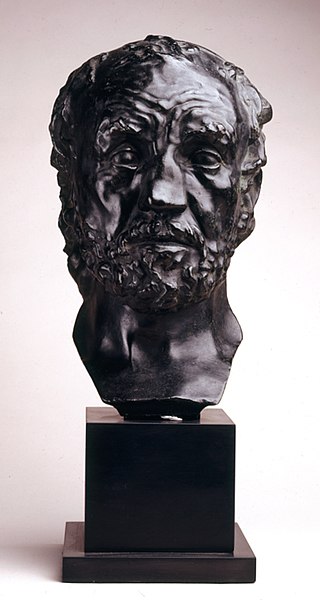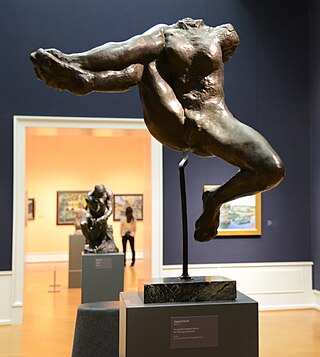
François Auguste René Rodin was a French sculptor generally considered the founder of modern sculpture. He was schooled traditionally and took a craftsman-like approach to his work. Rodin possessed a unique ability to model a complex, turbulent, and deeply pocketed surface in clay. He is known for such sculptures as The Thinker, Monument to Balzac, The Kiss, The Burghers of Calais, and The Gates of Hell.

Antoine Bourdelle, born Émile Antoine Bordelles, was an influential and prolific French sculptor and teacher. He was a student of Auguste Rodin, a teacher of Giacometti and Henri Matisse, and an important figure in the Art Deco movement and the transition from the Beaux-Arts style to modern sculpture.

The Thinker is a bronze sculpture by Auguste Rodin, situated atop a stone pedestal. The work depicts a nude male figure of heroic size sitting on a rock. He is seen leaning over, his right elbow placed on his left thigh, holding the weight of his chin on the back of his right hand. The pose is one of deep thought and contemplation, and the statue is often used as an image to represent philosophy.

The Burghers of Calais is a sculpture by Auguste Rodin in twelve original castings and numerous copies. It commemorates an event during the Hundred Years' War, when Calais, a French port on the English Channel, surrendered to the English after an eleven-month siege. The city commissioned Rodin to create the sculpture in 1884 and the work was completed in 1889.

The Kiss is an 1882 marble sculpture by the French sculptor Auguste Rodin.

The Gates of Hell is a monumental bronze sculptural group work by French artist Auguste Rodin that depicts a scene from the Inferno, the first section of Dante Alighieri's Divine Comedy. It stands at 6 metres high, 4 metres wide and 1 metre deep (19.7×13.1×3.3 ft) and contains 180 figures.

The Age of Bronze is a bronze statue by the French sculptor Auguste Rodin (1840–1917). The figure is of a life-size nude male, 72 in. (182.9 cm) high. Rodin continued to produce casts of the statue for several decades after it was modelled in 1876.

Monument to Balzac is a sculpture by Auguste Rodin in memory of the French novelist Honoré de Balzac. According to Rodin, the sculpture aims to portray the writer's persona rather than a physical likeness. The work was commissioned in 1891 by the Société des Gens de Lettres and a full-size plaster model was displayed in 1898 at a Salon in Champ de Mars. After coming under criticism the model was rejected by the société and Rodin moved it to his home in Meudon. On 2 July 1939 the model was cast in bronze for the first time and placed on the Boulevard du Montparnasse at the intersection with Boulevard Raspail.

Crouching Woman is a bronze sculpture by Auguste Rodin.

Saint John the Baptist (preaching) is a bronze sculpture, by Auguste Rodin.

Desolation is a sculpture that was crafted by Josep Llimona in 1907, which now resides in the National Art Museum of Catalonia in Barcelona.

The Spirit of Eternal Repose is a 1898–1899 sculpture of a sprite by French artist Auguste Rodin.

Cybele is a sculpture by French artist Auguste Rodin. It is one of the first of Rodin's partial figures known as "fragments" to be displayed as sculpture in its own right, rather than an incomplete study.

Brother and Sister is an 1890 bronze sculpture by Auguste Rodin.

Man with the Broken Nose is a sculpture by Auguste Rodin created between 1863 and 1864 and approved by the Salon in 1875. It is considered the first by Rodin in which life is represented over the grace pervading the academic circles and aesthetic of the time.

The Athlete is a 1901-1904 black-patina bronze sculpture by the French artist Auguste Rodin It measures 39,4 × 27,5 × 24,3 cm.

La Défense de Paris is a bronze statue by French sculptor Louis-Ernest Barrias. It commemorates the French dead from the Siege of Paris in 1870–71, during the Franco-Prussian War. The sculpture group was unveiled to the west of Paris on 12 October 1883, erected on an existing plinth that had previously supported a bronze sculpture of Napoleon by Charles Émile Seurre, alongside the crossroads between Courbevoie and Puteaux. The location became the La Défense roundabout, but the statue was later removed. The surrounding area was subsumed into Paris as the city expanded later in the 19th and in the 20th centuries; the area became known as La Défense after the statue. The statue was removed to a new location about 1965, and then moved several times before it was placed at its current location near the Arche de la Défense in 2017.

Iris, Messenger of the Gods is a bronze sculpture by Auguste Rodin. A plaster model, created between 1891 and 1894, was cast in bronze by Fonderie Rudier at various times from about 1895. Iris is depicted with her right hand clasping her right foot and her naked body posed provocatively with her legs spread wide, displaying her genitalia.





















